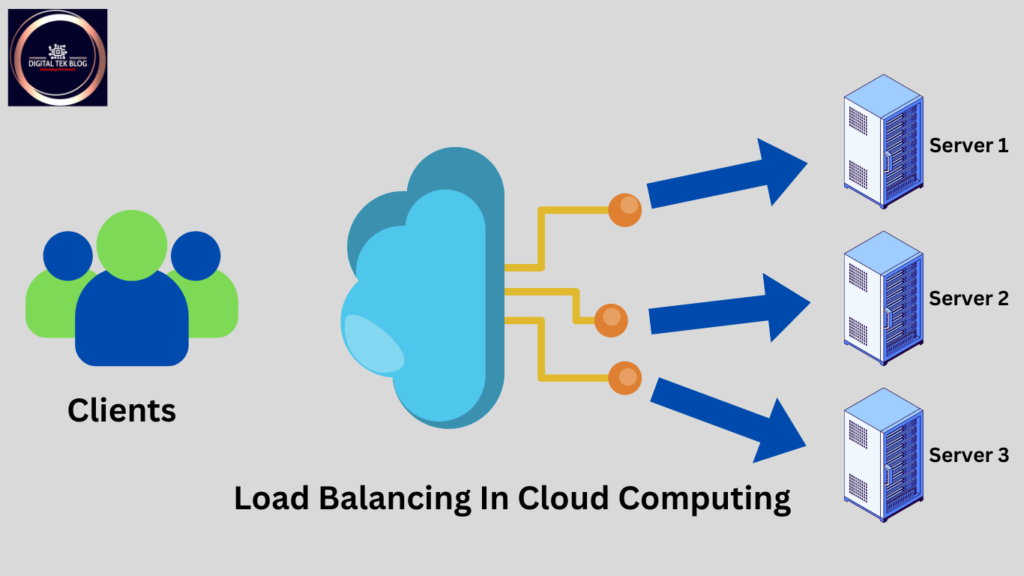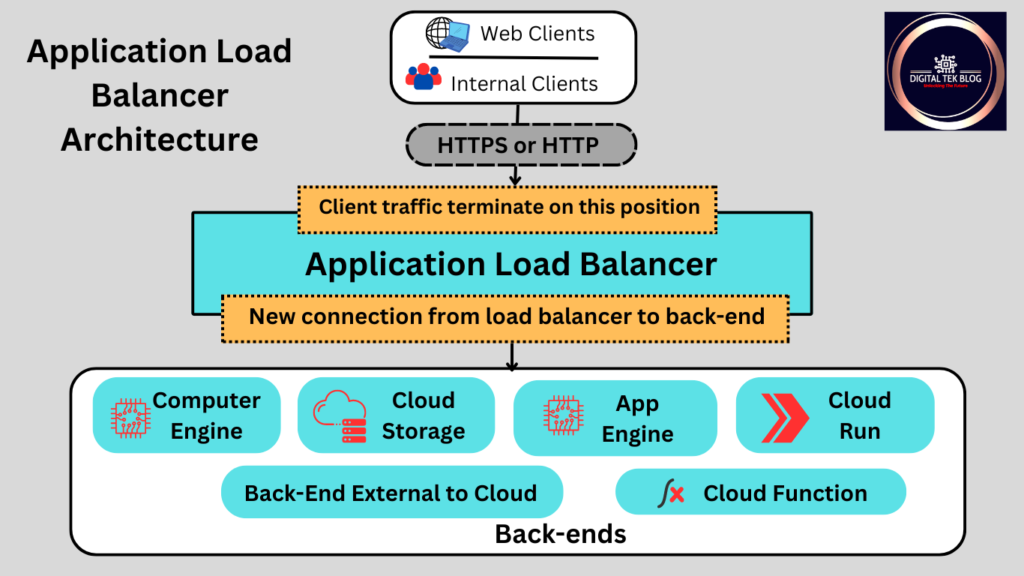Introduction: Load Balancing in Cloud Computing
Load balancing in cloud computing is defined as the distribution of traffic and workloads from no single server or overloaded server. Load balancing distributes the parameters of execution times, response time, and system stability to improve performance over the cloud.

You should know about related, important topics
Load balancing is an essential technique that is used in cloud computing to optimize resources and ensure that no single resource is overloaded with traffic. Load balancing is the process of distributing workloads among multiple resources, like servers and virtual machines, that can achieve the best performance and provide a better result. Load balancing in cloud computing can be implemented at various levels, like network load balancing, application level, database level, and cloud server level.
There are three most common load-balancing strategies implemented in cloud computing:
1. Network Layer Load Balancing
A network layer load balancer is a four-layer balancer that can handle network layer protocols like TCP, UDP, and others. Users pick these load balancers as per their needs, like applications and the types of traffic they need to handle. It is balancing the network traffic between different servers and instances. Load balancing is implanted on the network layer in cloud computing to manage the incoming and outgoing network traffic between various resources and servers.
2. Application Load Balancing
Application load balancing works on a proxy-based basis, where you can run the services on any IP address. It is distributed over HTTPS and HTTP traffic. It balances the workload of multiple instances of cloud computing applications. Application load balancing is implemented on the application layer, and it ensures that every instance receives and equals incoming and outgoing requests.
The application load balancer is deployed to depend on your requirements, either internally or externally.
- External Application Load Balancer: It is implemented to manage the service on the front-end. Users can use these load balancers from anywhere on the internet.
[icon name=”hand-point-right” prefix=”fas”] Notes
- Globally external application load balancer support is available in back-ends in different resources.
- Regionally external application load balancer support in backends in a single place.
- Classically external application load balancers are supported globally, but they are configured regionally.
Application load balancing use the open-source proxy to enable advanced traffic management.
- Internal Application Load Balancer: It is built on the Andromeda network virtualization stack and the open source proxy. This is the internal load balancing of the seven application data.
[icon name=”hand-point-right” prefix=”fas”] Notes
- Regional internal application load balancer support in back-end in single place
- Cross-region internal application load balancers support back-ends in different resources and are accessible globally only.

3. Database Load Balancing
It is implemented on multiple database servers. Database load balancing is implemented on the database layer of cloud computing.
Load balancing in cloud computing helps to improve zero-fault tolerance. It improves the overall performance of cloud computing applications and ensures no single-point failure. However, there are some advantages and disadvantages to load balancing in cloud computing.
Advantages of load balancing in cloud computing
- Performance: Load balancing helps to improve the workload and performance of servers and multiple resources.
- Availability: Load balancing provides no single downtime for all resources and systems. It provides high availability and zero fault tolerance to handle server failures.
- Scalability: It manages the high traffic demand as needed.
Disadvantages of load balancing in cloud computing
- Complexity: load balancing implementation is complex in cloud computing. It deals with large-scale systems. Implementing load balancing requires full planning and configuration to ensure that no downtime happens in the future.
- Cost: load balancing in cloud computing adds the cost of special hardware or software.
- Failure: Load balancing reduces the zero fault tolerance, but it becomes a single point of failure if not configured properly.
- Security: If load balancing is not configured correctly, it introduces a security risk. It allows unauthorized access and data security.
Overall, load balancing in cloud computing helps improve availability, utilization of resources, and scalability. So it is important that it is carefully implemented to implement load balancing and ensure that it works properly and no additional risk occurs. Implementing load balancing in cloud computing is beneficial for almost any type of service, like HTTP, SMTP, DNS, FTP, and POP/IMAP. Load balancing provides a dedicated hardware and software program. Load balancing can be categorized into two types: software-based and hardware-based.
Software-based: load balancing runs on standard hardware like desktops, computers, and special types of operating systems. Hardware-based: It is dedicated to special types of application circuits for particular uses.
Hardware load balancers allow for managing network traffic and transport. It is especially focused on transport network architecture.
Types of load balancing in cloud computing
This is why we need to understand the types of load balancing in cloud computing and network servers. There are three common load balancing methods used: for the relational database to check the server load balancing, for the troubleshooting of different geographic locations, global server load balancing, and to check domain-level functionality, domain name server load balancing. Load balancing can also be used on a cloud-based basis.
Network Load Balancing
In the cloud system, the load balancer checks the network layers to see where the network traffic should be sent. It means taking the network layer information from the load balancer, checking where traffic is low, and sending the traffic to that particular network layer. This method is used by Layer 4 balancing, which handles TCP, UDP, and IP traffic. This is the fastest solution for load balancing, but the disadvantage is that it cannot balance the traffic distribution over the network.
HTTSs Load balancing
This is oldest Layer 7 load balancing types. Load balancing operates in layers. It is most flexible because it delivers decisions based on the information collected on the HTTP address.
Internal Load balancing
It is used to balance the infrastructure of internal network.
Hardware Load Balancer
A hardware load balancer is based on physical hardware to distribute network and application traffic. A hardware load balancer can handle the huge network traffic, but it is costly and flexible to use.
Software Load Balancer
This is open-source software, but before use, it should be installed.
Virtual Load Balancer
It works on a virtual machine. It is the same as a software load balancer, but it is deployed only on a virtual machine.
What are load-balancing algorithms in cloud computing?
The load balancing algorithm is the set of rules that follow the client request on the best server. There are two main categories of load-balancing algorithms:
1. Static load balancing
There are fixed rules to follow, and they are independent of the current running server. There are some example of static load balancing:
Round-robin method
In the round-robin method, there is an IP address of the server that sends the request to client, but IP address is difficult to remember for the server so DNS maps the website name to server. For example, when you type google.com into the browser, first request will be go to the DNS server and DNS will provide the IP address to the browser After that, you will get the google page on your browser.
Here, the authorities of load balancing is the Domain Name Server, which has specialized hardware and software. domain server provides the IP address to another server, and this process goes round-robin.
Weighted round-robin method
In this method, you can assign weight to servers according to their functionality, capacity, and priority. If server has higher weight, it means that it will receive more incoming applications traffic from the domain server.
IP hash method
It is work on hashing techniques. It converts the IP address to the number, then maps to allotted server. IP hashing techniques perform the mathematical computation.
2. Dynamic load balancing
It perform on the current state of the server before traffic is distributed. There are some example of dynamic load balancing:
Least connection method

The client and server communicate through an open-source connection. The client sends the request to the server; the server authenticates and establishes the connection between client and server. Load balancer check, which has a low active connection; after that, it sends the traffic to that server.
Weighted least connection method
In this algorithm method, some servers handle more active connections compared to other servers. So, you can assign different weights or capacities to servers according to functionality, and load balancers can send client requests with low connections based on their capacity.
Least response time method
server takes the total time to process the incoming data and send a response. The combine’s method of server response time and total active connection for the best server is called least response time method. Provide fast services to all users. A load balancer is used for this method.
Resource-based method
First, analyze how much load the current server is carrying by the load balancer. An agent (called special software) runs on each server to determine the resources and usages of the server and provide free resources to send the traffic on the free server.
follow me : Twitter, Facebook, LinkedIn, Instagram

